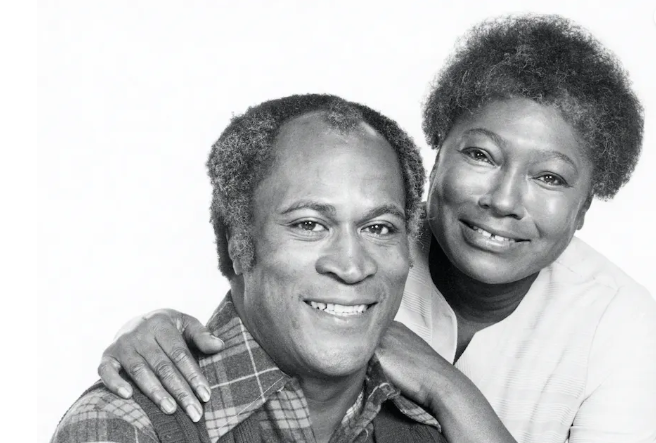

Angela M. Nelson, Bowling Green State University
I loved watching Norman Lear’s trailblazing television shows when I was growing up in Dalzell, South Carolina, in the 1970s.
“Good Times,” my favorite, debuted on Feb. 8, 1974 – nearly 50 years ago. CBS aired the show about the daily struggles and triumphs of the working-class Evans family until Aug. 1, 1979.
Lear, who died at 101 on Dec. 5, 2023, forever changed sitcoms. His characters were more diverse, and their predicaments included situations that had previously been out of bounds for humorous TV programs, such as child abuse, unemployment and alcoholism. As a result, they more accurately reflected modern life in America than their counterparts that predominated through the 1960s.
“Good Times” stood apart from Lear’s other successful comedies because it featured, as Lear put it, the “first full black family on television.”
I have been researching “Good Times” and other shows with primarily Black casts since 1989. Along the way, I’ve developed a deep appreciation for the show’s strong female characters and its many nods to Black popular culture. https://www.youtube.com/embed/BqR4S40FtgY?wmode=transparent&start=0 The catchy ‘Good Times’ theme song emphasized both hardship and resilience.
Compelling characters
“Good Times” starred actress Esther Rolle. She had previously been cast as a domestic worker with the same name but in a different city in “Maude,” another popular show Lear produced. “Maude” was also a spinoff – its main character originated on “All in the Family,” Lear’s first breakthrough hit.
On “Good Times,” Rolle’s character, Florida Evans, was a loving wife and mother. She was married to James Evans Sr. Her hardworking and easily angered husband was played by John Amos until 1976.
Their children included J.J. – James Jr. – the eldest son and a talented painter. He was played by stand-up comedian Jimmie Walker. The gangly young man won viewers’ devotion by frequently shouting “dyn-o-mite!” to express his excitement.
Bern Nadette Stanis had the role of Thelma, the middle child and only daughter. She aspired to be a doctor, and her beauty attracted many suitors her parents found unsuitable. Michael, the militant youngest son who often expressed his indignation over social justice issues starting as a young tween, was played by Ralph Carter.
The actress Ja’net DuBois rounded out the core cast as Willona Woods, the Evans’ fashionable, sassy neighbor who was virtually another member of this boisterous and tight-knit family. Other actors rotated in and out, including a very young Janet Jackson cast as Willona’s adopted daughter, Penny. https://www.youtube.com/embed/9FL8rWksRxI?wmode=transparent&start=0 ‘Good Times’ episodes had themes that were relatable to all viewers, including sibling rivalry and conflict between parents and their older children.
Familiar folks
The Black characters in “Good Times” looked and sounded real to Black viewers. Also, Florida had authority in her home, just as her husband, James, did.
The Evans family and Willona resonated with me because they authentically presented African American culture on the small screen. Their speech, hairstyles, clothes, dance moves and music were recognizable to me as a young Black girl.
The cast regularly referenced Black pop culture icons, including Ebony magazine, the comedian and variety show host Flip Wilson, and the composer and musician Isaac Hayes.
“Good Times” also made a mark because Black women had agency on and off the set. Rolle openly shared her concerns with Lear and other producers about the show’s direction.
Rolle wanted more stories that focused on the show’s female Black characters. And she got them.
Thelma was the first Black teenage girl and Willona was the first Black female divorcée on prime-time television. Both characters were interesting, funny and beautiful.
Race’s role
One way that “Good Times” differed from Lear’s other Black-cast sitcoms was the role that race played.
In “Sanford and Son,” which revolved around a Los Angeles junk dealer and his adult son, and “The Jeffersons,” in which the audience saw a successful Black entrepreneur and his wife “movin’ on up” to a fancy Manhattan apartment, the protagonists disliked and distrusted white people. And they let everyone know it.
The Evans family, on the other hand, were mostly cordial and welcoming in their interactions with the white characters who infrequently appeared in “Good Times.” They also turned distant and aloof when racism intervened, as happened in the episode “Thelma’s Scholarship.”
Thelma and her family are initially thrilled by the prospect of getting a full ride to a boarding school in Michigan. But they reject the opportunity in disgust when it turns out she would have become a token Black student rather than being valued for her academic achievement and potential. https://www.youtube.com/embed/fsl2Lkxzb6s?wmode=transparent&start=0 Thelma beams while telling her family about her shot at a scholarship to a prestigious boarding school.
Normal people’s problems
“Good Times” also broke ground because the Evanses lived in poverty. Their fictional, cramped two-bedroom apartment was in Chicago’s very real Cabrini-Green Homes, which the city has since demolished after years of neglect.
The hassles and heartaches tied to their housing problems often became part of the plotlines.
In contrast, typical TV families in the 1950s and 1960s were white, middle class and suburban.
These included the Nelsons in “The Adventures of Ozzie and Harriet,” the Andersons in “Father Knows Best” and the Stones in “The Donna Reed Show.”
The Nelsons, Andersons and Stones, however, also had some things in common with the Evans family.
For example, Betty Anderson in “Father Knows Best” contemplated marrying her boyfriend in the episode “Vine Covered Cottage,” as did Thelma in “Thelma’s Young Man.” Michael dealt with a bully in “The Lunch Money Rip-Off,” as did Bud Anderson in “Bud, the Boxer.”
“Good Times” showed that Black families had many of the same problems and concerns as white families.
‘Good Times’ reboot
I believe that “Good Times” lives on in contemporary depictions of 21st-century, urban, Black, working-class nuclear families. Netflix’s “The Upshaws” is the most recent example of a two-parent, Black, working-class nuclear family with children.
Like Lear’s comedies, “The Upshaws” is packed with situations that would have been out of bounds before Lear redefined TV sitcoms – such as adultery and gay central characters.
And, as it happens, “Good Times” itself is being reincarnated.
“Family Guy” creator Seth MacFarlane and NBA star Stephen Curry joined with Lear in 2020 to executive-produce an adult animated reboot.
The series, slated for release in 2024 on Netflix, will follow a new generation of the Evans family 50 years after it first showed up in American living rooms. Lear will reportedly make a posthumous cameo appearance in it.
I hope a new generation of viewers will find as much to revere in the new “Good Times” as I have in the old one.
Angela M. Nelson, Associate Professor of Popular Culture, Bowling Green State University
This article is republished from The Conversation under a Creative Commons license. Read the original article.



















